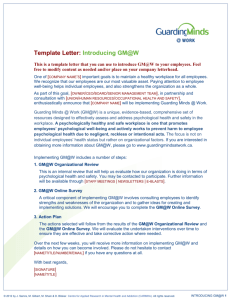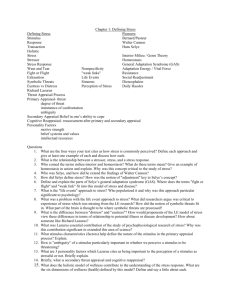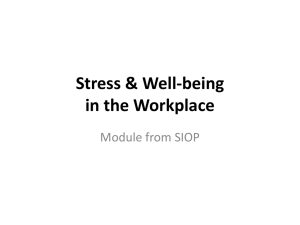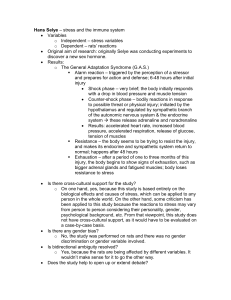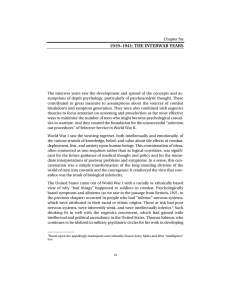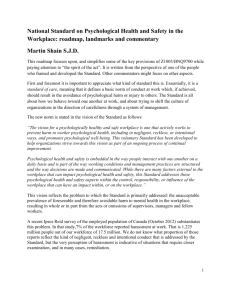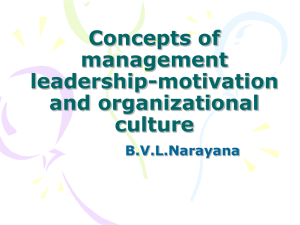Carla2011_Stress in the workplace
advertisement
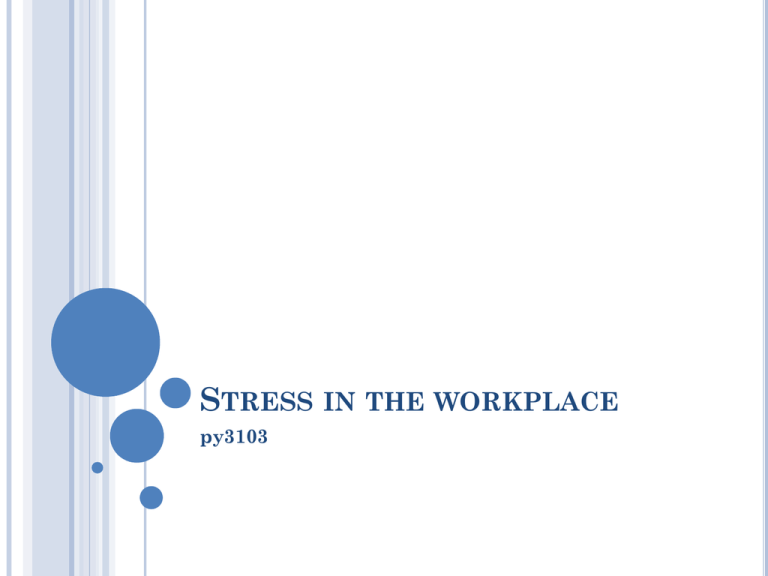
STRESS IN THE WORKPLACE py3103 LEARNING OUTCOMES At the end of this session and with additional reading you will be able to Describe different types and approaches to stress in the workplace WHY IS IT IMPORTANT Stress affects health Increased level of absenteeism due to stress symptoms (2007-8 15.5 million days lost) Increase in reported levels 528% between the years 1955-1979 Cost of stress to organisations estimated at £5 billion a year (10% of Gross National Product) What are your experiences of stress in the workplace ? WHAT IS JOB STRESS Original definition was derived from engineering – the force/pressure on a person A person can take an amount of pressure – but when that pressure becomes to much for an individual it may have serious negative affects TYPES OF WORK STRESS Job content Job overload/under load Job complexity/monotony Working conditions Dangerous conditions Employment conditions Shift patterns Low pay Job insecurity Social relations at work STRESS SYMPTOMS level individual interpersonal organisational Affective Anxiety Anger Depression Irritability oversensitive Job dissatisfaction Cognitive Helplessness Impaired decision making Hostility Suspicion projection Cynicism distrust Physical Headaches coronary disease Behavioural Hyperactivity Need for stimulants Aggressive behaviour Social isolation Sick absence Reduced work performance APPROACHES TO STRESS Stress can be viewed in 3 ways As a stimulus As a psychological or physiological response Stress as a meditational process THEORETICAL PERSPECTIVES ON JOB STRESS Stimulus model General Adaptation Syndrome (Selye) Stimulus response Cox Cognitive appraisal (Lazarus Process models The Michigan model The vitamin model The demand-control model GENERAL ADAPTATION SYNDROME (GAS (HAN SELYE, 1907-1982) 1) a set of conditions that could be physical or physiological and 2) a set of non-specific biological responses including increase in heart rate, blood pressure and sweating. GENERAL ADAPTATION SYNDROME GAS) The alarm stage refers to an organism’s fightflight response suggesting that an immediate response to stress was to fight, or flight to safety Resistance, would then unfold. In the resistance stage, in order to counteract the body’s reaction to alarm which caused depletion in the stores of the adrenal gland, the organism is able to regain some of the store of depleted glands to ensure that the fight for life can continue. Finally, following continued exposure to stress, Selye suggests, the organism enters the third stage of GAS namely, exhaustion. Here, the last defences are used up and the body is no longer able to continue its fight. THE COGNITIVE APPRAISAL MODEL Lazarus and Folkman (1984) believed that any conceptualisation of stress could not be independent of a person’s appraisal of the situation It follows that any event may potentially be appraised, and thus experienced, by an individual as stressful, such as moving house, or a visit to the dentist. THE MICHIGAN MODEL INSTITUTE FOR SOCIAL RESEARCH) Attributions of the individual Organisation Psychological stressors Interpersonal relations Stress reactions Illness THE VITAMIN MODEL (WARR 1987, 1994) Consent effect Additional decrement Availability of money Physical security Valued social position Opportunity for control Opportunity for skill use Externally generated goals Variety Environmental clarity Opportunity for interpersonal contact THE VITAMIN MODEL (WARR 1987, 1994) The model postulated that low levels of vitamins can lead to poor levels of mental health whilst at the same time, too high a level of vitamins ceases to be beneficial to the individual In other words there is a point when increasing rewards will no longer render any significant improvements in the mental health of a worker This was due to a saturation point akin to the process that often occurs within the body’s uptake of vitamins, in that after a certain point there is no benefit from increasing the dose. THE DEMAND-CONTROL MODEL (KARASEK, 1979, 1990) Psychological demands Low High High Decision Low strain Active Latitude Passive (Control) Low High strain THE DEMAND CONTROL MODEL II Work stress is an interaction between decision latitude (how much control a worker has over what they are doing and how they do it), and the demands of the job (an individual’s subjective perception of her/his capacities to meet the psychological demands of a task) Those who are in highly demanding jobs and find themselves in high psychological demand are not without stress even though such individuals may also experience high control. The control allows an individual to develop protective behaviours and manage stress in an active and more efficient manner SOCIAL IDENTITY AND STRESS Haslam (2004) suggested that the experience of stress in the workplace can be linked to i) the activities of a particular occupation and ii) how that group/occupation is structured and managed, and ii) that group process which may be seen to help reduce stress in the workplace can also be the cause. THE ROLE OF SOCIAL SUPPORT Social support is through to have a stress educing function:Social integration Satisfying relationships Perceive available support Actually receive support INDIVIDUAL DIFFERENCES Do some occupations cause more stress than others ? REFERENCES Chmiel, N (2000) Introduction to work and organizational psychology: A European perspective, Blackwell
